Financial Accounting for Startups: Business Structure and Statements
VerifiedAdded on 2022/10/04
|6
|1408
|17
Report
AI Summary
This report delves into the essential aspects of financial accounting tailored for startup businesses. It begins by comparing different business structures, including sole proprietorships, partnerships, LLCs, and corporations, emphasizing the implications of each choice for a new venture. The report then addresses crucial decisions such as hiring versus forming partnerships and highlights the importance of various financial statements like the balance sheet, income statement, and statement of equity. It also covers the need for accurate accounting records, distinguishing between essential and non-essential documentation. Furthermore, the report examines the insights gained from financial statements, emphasizing the need to consider factors beyond cash flow for assessing a startup's health. Finally, it touches upon common operational challenges faced in the initial months and considerations for business expansion. The report provides a comprehensive guide for Ron, offering valuable insights into establishing a robust financial foundation for his startup, REC.

1
Financial accounting
Financial accounting
Paraphrase This Document
Need a fresh take? Get an instant paraphrase of this document with our AI Paraphraser
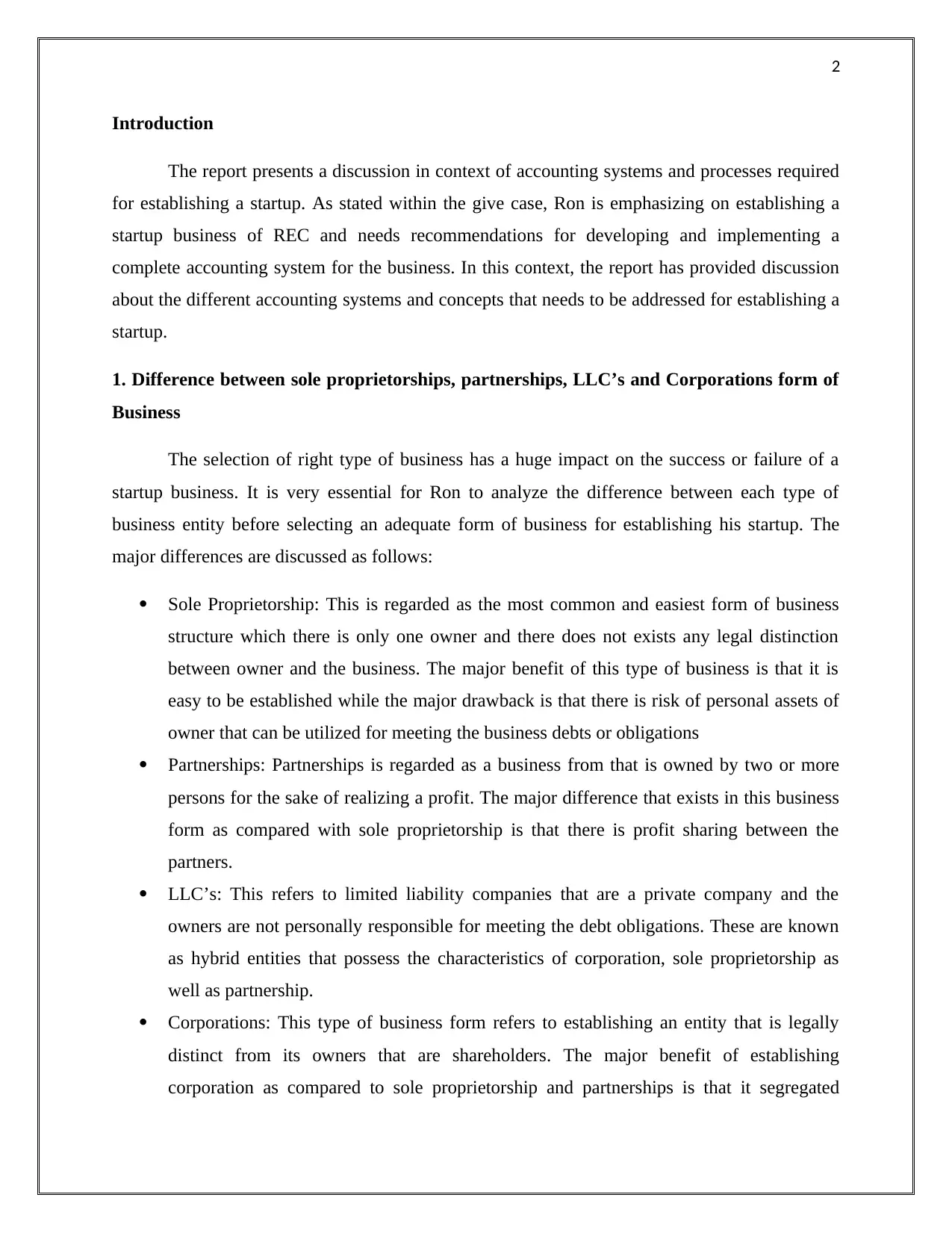
2
Introduction
The report presents a discussion in context of accounting systems and processes required
for establishing a startup. As stated within the give case, Ron is emphasizing on establishing a
startup business of REC and needs recommendations for developing and implementing a
complete accounting system for the business. In this context, the report has provided discussion
about the different accounting systems and concepts that needs to be addressed for establishing a
startup.
1. Difference between sole proprietorships, partnerships, LLC’s and Corporations form of
Business
The selection of right type of business has a huge impact on the success or failure of a
startup business. It is very essential for Ron to analyze the difference between each type of
business entity before selecting an adequate form of business for establishing his startup. The
major differences are discussed as follows:
Sole Proprietorship: This is regarded as the most common and easiest form of business
structure which there is only one owner and there does not exists any legal distinction
between owner and the business. The major benefit of this type of business is that it is
easy to be established while the major drawback is that there is risk of personal assets of
owner that can be utilized for meeting the business debts or obligations
Partnerships: Partnerships is regarded as a business from that is owned by two or more
persons for the sake of realizing a profit. The major difference that exists in this business
form as compared with sole proprietorship is that there is profit sharing between the
partners.
LLC’s: This refers to limited liability companies that are a private company and the
owners are not personally responsible for meeting the debt obligations. These are known
as hybrid entities that possess the characteristics of corporation, sole proprietorship as
well as partnership.
Corporations: This type of business form refers to establishing an entity that is legally
distinct from its owners that are shareholders. The major benefit of establishing
corporation as compared to sole proprietorship and partnerships is that it segregated
Introduction
The report presents a discussion in context of accounting systems and processes required
for establishing a startup. As stated within the give case, Ron is emphasizing on establishing a
startup business of REC and needs recommendations for developing and implementing a
complete accounting system for the business. In this context, the report has provided discussion
about the different accounting systems and concepts that needs to be addressed for establishing a
startup.
1. Difference between sole proprietorships, partnerships, LLC’s and Corporations form of
Business
The selection of right type of business has a huge impact on the success or failure of a
startup business. It is very essential for Ron to analyze the difference between each type of
business entity before selecting an adequate form of business for establishing his startup. The
major differences are discussed as follows:
Sole Proprietorship: This is regarded as the most common and easiest form of business
structure which there is only one owner and there does not exists any legal distinction
between owner and the business. The major benefit of this type of business is that it is
easy to be established while the major drawback is that there is risk of personal assets of
owner that can be utilized for meeting the business debts or obligations
Partnerships: Partnerships is regarded as a business from that is owned by two or more
persons for the sake of realizing a profit. The major difference that exists in this business
form as compared with sole proprietorship is that there is profit sharing between the
partners.
LLC’s: This refers to limited liability companies that are a private company and the
owners are not personally responsible for meeting the debt obligations. These are known
as hybrid entities that possess the characteristics of corporation, sole proprietorship as
well as partnership.
Corporations: This type of business form refers to establishing an entity that is legally
distinct from its owners that are shareholders. The major benefit of establishing
corporation as compared to sole proprietorship and partnerships is that it segregated
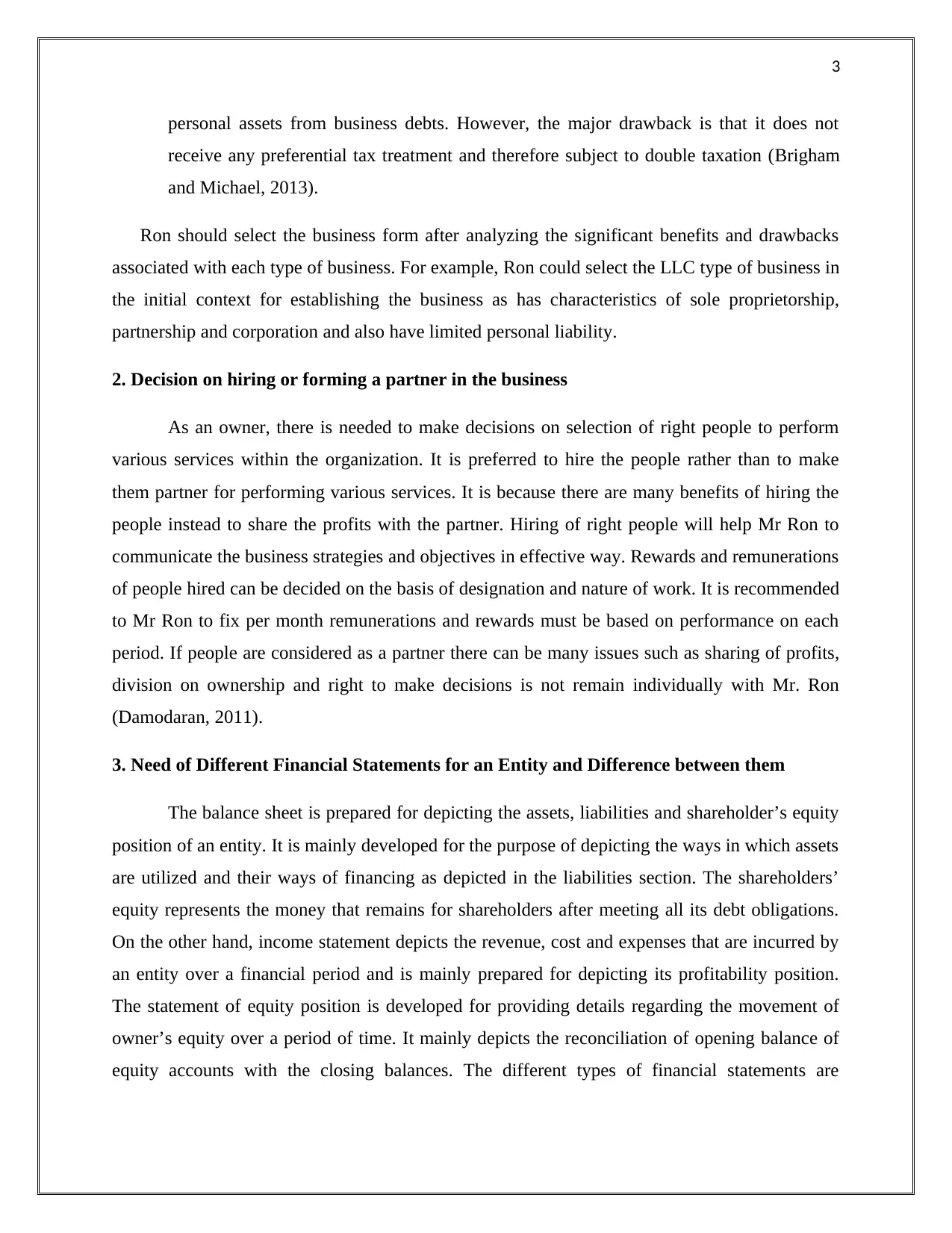
3
personal assets from business debts. However, the major drawback is that it does not
receive any preferential tax treatment and therefore subject to double taxation (Brigham
and Michael, 2013).
Ron should select the business form after analyzing the significant benefits and drawbacks
associated with each type of business. For example, Ron could select the LLC type of business in
the initial context for establishing the business as has characteristics of sole proprietorship,
partnership and corporation and also have limited personal liability.
2. Decision on hiring or forming a partner in the business
As an owner, there is needed to make decisions on selection of right people to perform
various services within the organization. It is preferred to hire the people rather than to make
them partner for performing various services. It is because there are many benefits of hiring the
people instead to share the profits with the partner. Hiring of right people will help Mr Ron to
communicate the business strategies and objectives in effective way. Rewards and remunerations
of people hired can be decided on the basis of designation and nature of work. It is recommended
to Mr Ron to fix per month remunerations and rewards must be based on performance on each
period. If people are considered as a partner there can be many issues such as sharing of profits,
division on ownership and right to make decisions is not remain individually with Mr. Ron
(Damodaran, 2011).
3. Need of Different Financial Statements for an Entity and Difference between them
The balance sheet is prepared for depicting the assets, liabilities and shareholder’s equity
position of an entity. It is mainly developed for the purpose of depicting the ways in which assets
are utilized and their ways of financing as depicted in the liabilities section. The shareholders’
equity represents the money that remains for shareholders after meeting all its debt obligations.
On the other hand, income statement depicts the revenue, cost and expenses that are incurred by
an entity over a financial period and is mainly prepared for depicting its profitability position.
The statement of equity position is developed for providing details regarding the movement of
owner’s equity over a period of time. It mainly depicts the reconciliation of opening balance of
equity accounts with the closing balances. The different types of financial statements are
personal assets from business debts. However, the major drawback is that it does not
receive any preferential tax treatment and therefore subject to double taxation (Brigham
and Michael, 2013).
Ron should select the business form after analyzing the significant benefits and drawbacks
associated with each type of business. For example, Ron could select the LLC type of business in
the initial context for establishing the business as has characteristics of sole proprietorship,
partnership and corporation and also have limited personal liability.
2. Decision on hiring or forming a partner in the business
As an owner, there is needed to make decisions on selection of right people to perform
various services within the organization. It is preferred to hire the people rather than to make
them partner for performing various services. It is because there are many benefits of hiring the
people instead to share the profits with the partner. Hiring of right people will help Mr Ron to
communicate the business strategies and objectives in effective way. Rewards and remunerations
of people hired can be decided on the basis of designation and nature of work. It is recommended
to Mr Ron to fix per month remunerations and rewards must be based on performance on each
period. If people are considered as a partner there can be many issues such as sharing of profits,
division on ownership and right to make decisions is not remain individually with Mr. Ron
(Damodaran, 2011).
3. Need of Different Financial Statements for an Entity and Difference between them
The balance sheet is prepared for depicting the assets, liabilities and shareholder’s equity
position of an entity. It is mainly developed for the purpose of depicting the ways in which assets
are utilized and their ways of financing as depicted in the liabilities section. The shareholders’
equity represents the money that remains for shareholders after meeting all its debt obligations.
On the other hand, income statement depicts the revenue, cost and expenses that are incurred by
an entity over a financial period and is mainly prepared for depicting its profitability position.
The statement of equity position is developed for providing details regarding the movement of
owner’s equity over a period of time. It mainly depicts the reconciliation of opening balance of
equity accounts with the closing balances. The different types of financial statements are
⊘ This is a preview!⊘
Do you want full access?
Subscribe today to unlock all pages.

Trusted by 1+ million students worldwide
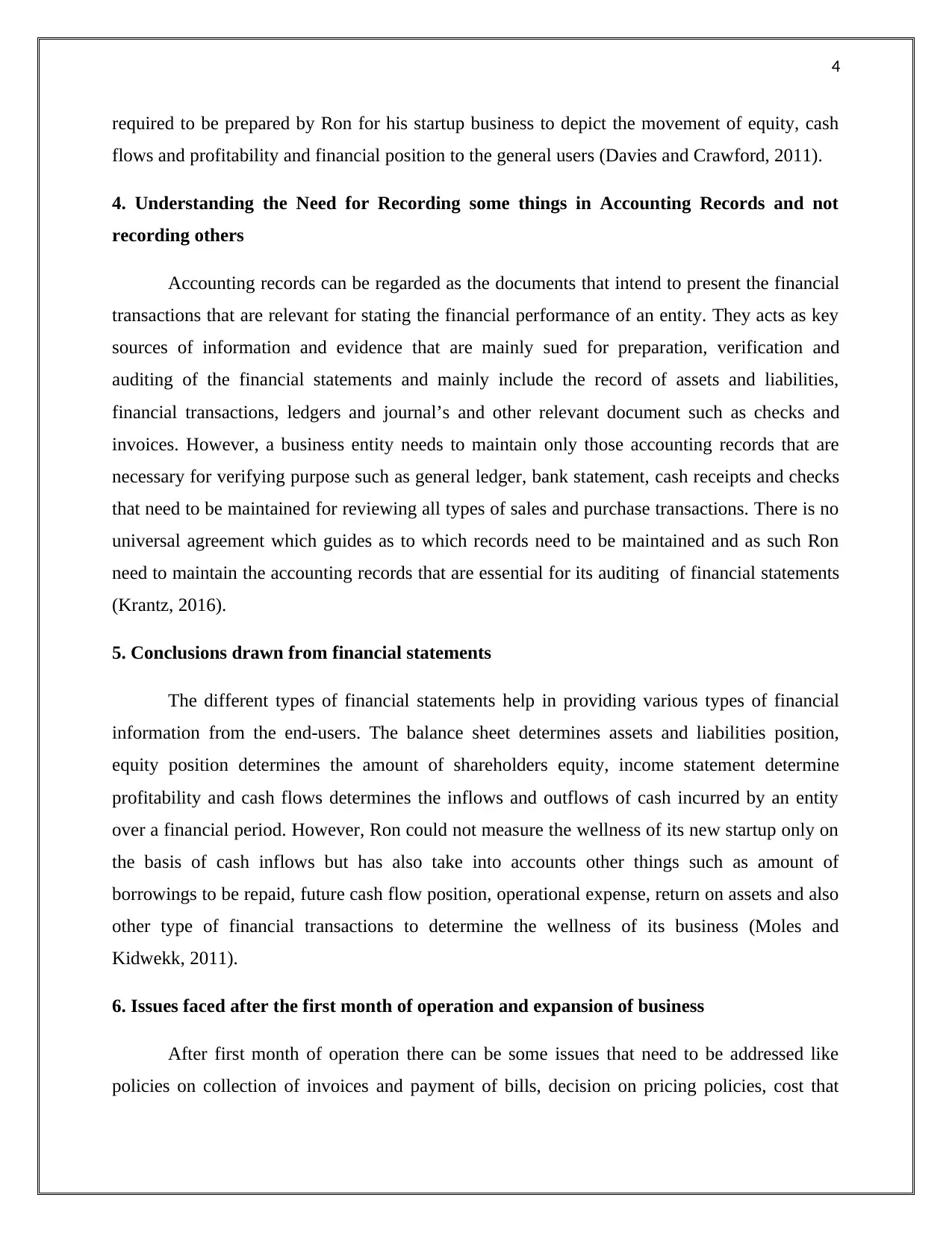
4
required to be prepared by Ron for his startup business to depict the movement of equity, cash
flows and profitability and financial position to the general users (Davies and Crawford, 2011).
4. Understanding the Need for Recording some things in Accounting Records and not
recording others
Accounting records can be regarded as the documents that intend to present the financial
transactions that are relevant for stating the financial performance of an entity. They acts as key
sources of information and evidence that are mainly sued for preparation, verification and
auditing of the financial statements and mainly include the record of assets and liabilities,
financial transactions, ledgers and journal’s and other relevant document such as checks and
invoices. However, a business entity needs to maintain only those accounting records that are
necessary for verifying purpose such as general ledger, bank statement, cash receipts and checks
that need to be maintained for reviewing all types of sales and purchase transactions. There is no
universal agreement which guides as to which records need to be maintained and as such Ron
need to maintain the accounting records that are essential for its auditing of financial statements
(Krantz, 2016).
5. Conclusions drawn from financial statements
The different types of financial statements help in providing various types of financial
information from the end-users. The balance sheet determines assets and liabilities position,
equity position determines the amount of shareholders equity, income statement determine
profitability and cash flows determines the inflows and outflows of cash incurred by an entity
over a financial period. However, Ron could not measure the wellness of its new startup only on
the basis of cash inflows but has also take into accounts other things such as amount of
borrowings to be repaid, future cash flow position, operational expense, return on assets and also
other type of financial transactions to determine the wellness of its business (Moles and
Kidwekk, 2011).
6. Issues faced after the first month of operation and expansion of business
After first month of operation there can be some issues that need to be addressed like
policies on collection of invoices and payment of bills, decision on pricing policies, cost that
required to be prepared by Ron for his startup business to depict the movement of equity, cash
flows and profitability and financial position to the general users (Davies and Crawford, 2011).
4. Understanding the Need for Recording some things in Accounting Records and not
recording others
Accounting records can be regarded as the documents that intend to present the financial
transactions that are relevant for stating the financial performance of an entity. They acts as key
sources of information and evidence that are mainly sued for preparation, verification and
auditing of the financial statements and mainly include the record of assets and liabilities,
financial transactions, ledgers and journal’s and other relevant document such as checks and
invoices. However, a business entity needs to maintain only those accounting records that are
necessary for verifying purpose such as general ledger, bank statement, cash receipts and checks
that need to be maintained for reviewing all types of sales and purchase transactions. There is no
universal agreement which guides as to which records need to be maintained and as such Ron
need to maintain the accounting records that are essential for its auditing of financial statements
(Krantz, 2016).
5. Conclusions drawn from financial statements
The different types of financial statements help in providing various types of financial
information from the end-users. The balance sheet determines assets and liabilities position,
equity position determines the amount of shareholders equity, income statement determine
profitability and cash flows determines the inflows and outflows of cash incurred by an entity
over a financial period. However, Ron could not measure the wellness of its new startup only on
the basis of cash inflows but has also take into accounts other things such as amount of
borrowings to be repaid, future cash flow position, operational expense, return on assets and also
other type of financial transactions to determine the wellness of its business (Moles and
Kidwekk, 2011).
6. Issues faced after the first month of operation and expansion of business
After first month of operation there can be some issues that need to be addressed like
policies on collection of invoices and payment of bills, decision on pricing policies, cost that
Paraphrase This Document
Need a fresh take? Get an instant paraphrase of this document with our AI Paraphraser
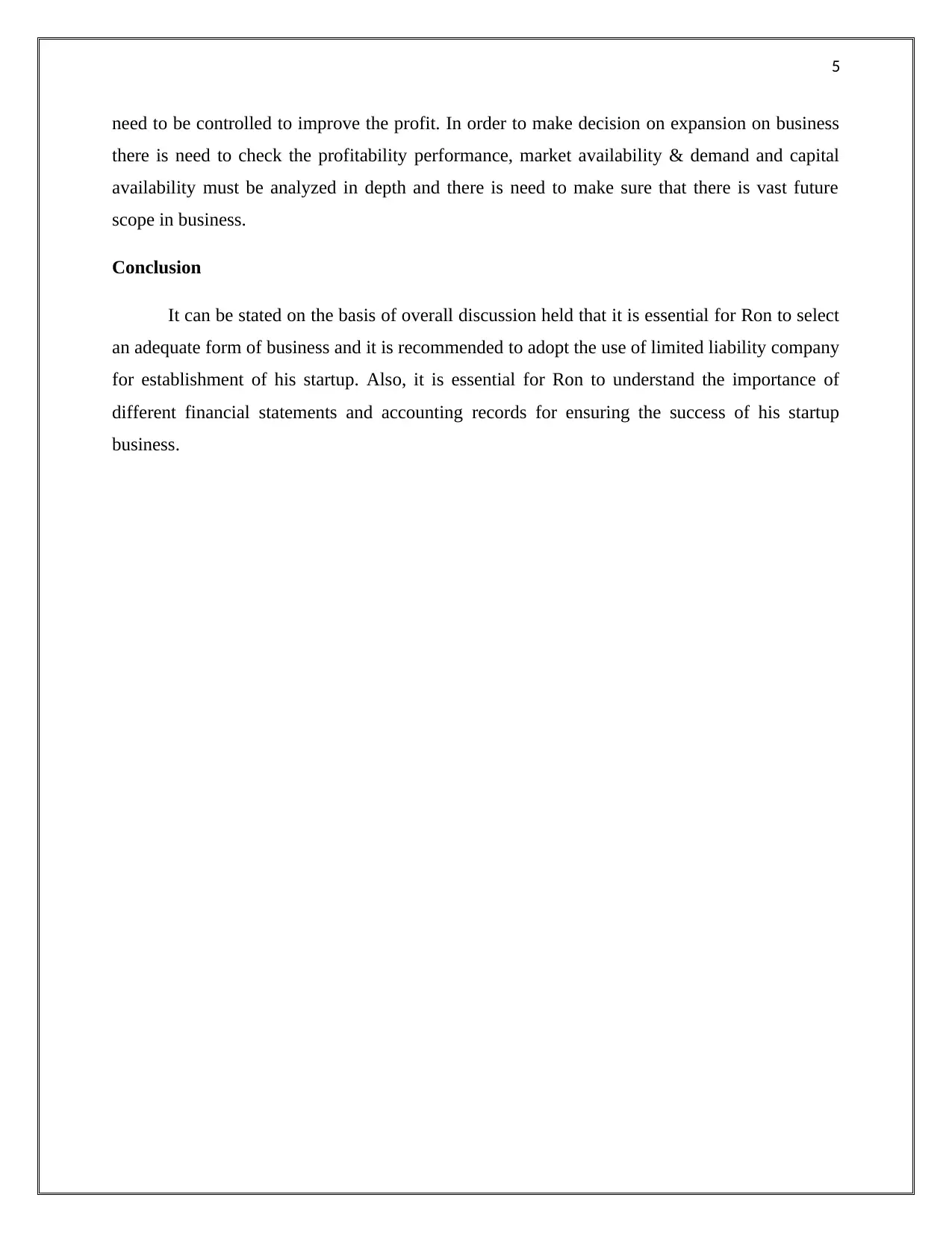
5
need to be controlled to improve the profit. In order to make decision on expansion on business
there is need to check the profitability performance, market availability & demand and capital
availability must be analyzed in depth and there is need to make sure that there is vast future
scope in business.
Conclusion
It can be stated on the basis of overall discussion held that it is essential for Ron to select
an adequate form of business and it is recommended to adopt the use of limited liability company
for establishment of his startup. Also, it is essential for Ron to understand the importance of
different financial statements and accounting records for ensuring the success of his startup
business.
need to be controlled to improve the profit. In order to make decision on expansion on business
there is need to check the profitability performance, market availability & demand and capital
availability must be analyzed in depth and there is need to make sure that there is vast future
scope in business.
Conclusion
It can be stated on the basis of overall discussion held that it is essential for Ron to select
an adequate form of business and it is recommended to adopt the use of limited liability company
for establishment of his startup. Also, it is essential for Ron to understand the importance of
different financial statements and accounting records for ensuring the success of his startup
business.
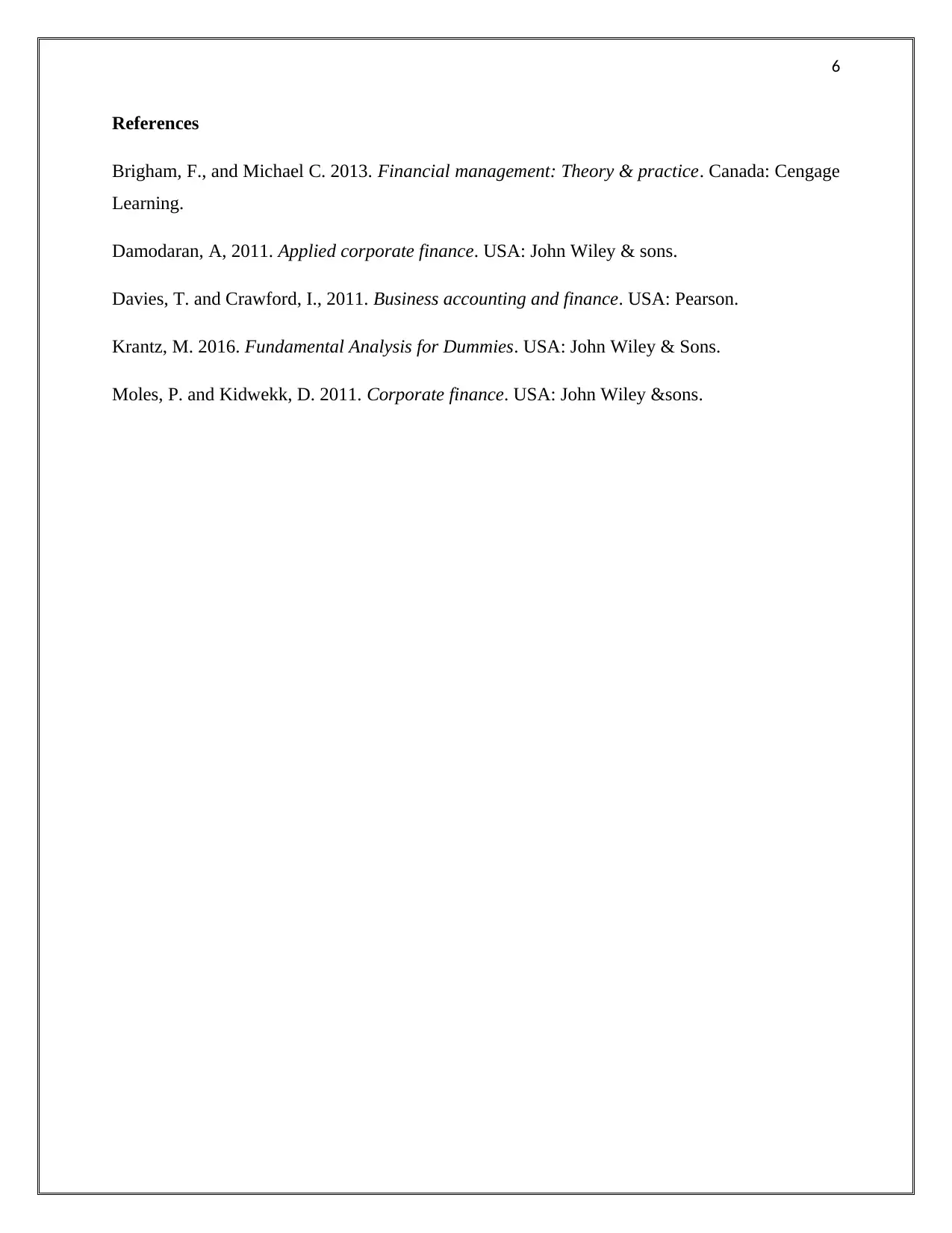
6
References
Brigham, F., and Michael C. 2013. Financial management: Theory & practice. Canada: Cengage
Learning.
Damodaran, A, 2011. Applied corporate finance. USA: John Wiley & sons.
Davies, T. and Crawford, I., 2011. Business accounting and finance. USA: Pearson.
Krantz, M. 2016. Fundamental Analysis for Dummies. USA: John Wiley & Sons.
Moles, P. and Kidwekk, D. 2011. Corporate finance. USA: John Wiley &sons.
References
Brigham, F., and Michael C. 2013. Financial management: Theory & practice. Canada: Cengage
Learning.
Damodaran, A, 2011. Applied corporate finance. USA: John Wiley & sons.
Davies, T. and Crawford, I., 2011. Business accounting and finance. USA: Pearson.
Krantz, M. 2016. Fundamental Analysis for Dummies. USA: John Wiley & Sons.
Moles, P. and Kidwekk, D. 2011. Corporate finance. USA: John Wiley &sons.
⊘ This is a preview!⊘
Do you want full access?
Subscribe today to unlock all pages.

Trusted by 1+ million students worldwide
1 out of 6
Related Documents
Your All-in-One AI-Powered Toolkit for Academic Success.
+13062052269
info@desklib.com
Available 24*7 on WhatsApp / Email
![[object Object]](/_next/static/media/star-bottom.7253800d.svg)
Unlock your academic potential
Copyright © 2020–2025 A2Z Services. All Rights Reserved. Developed and managed by ZUCOL.





